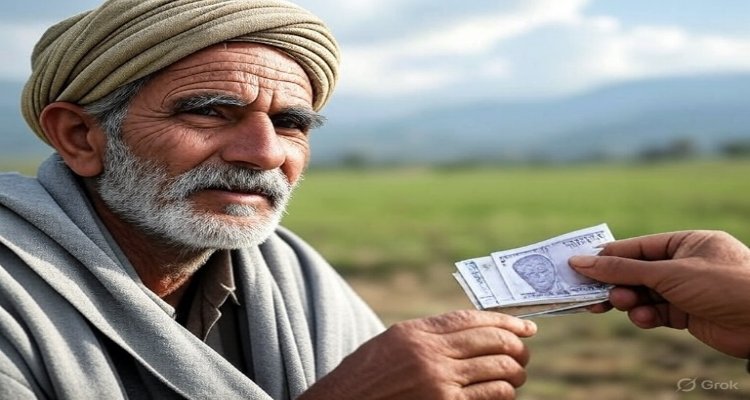Centre Releases 21st Instalment of PM-KISAN Scheme to Support Flood-Hit Farmers

The Centre has released the 21st instalment of the PM-KISAN scheme, transferring ₹540 crore to over 27 lakh farmers in Himachal Pradesh, Punjab, and Uttarakhand affected by recent floods and landslides.
A Timely Lifeline for Struggling Farmers
On September 27, the Government of India released the 21st instalment of the Pradhan Mantri Kisan Samman Nidhi (PM-KISAN) scheme, providing much-needed financial relief to farmers across three disaster-struck states. Over ₹540 crore has been transferred directly into the bank accounts of more than 27 lakh farmers, including nearly 2.7 lakh women farmers in Himachal Pradesh, Punjab, and Uttarakhand—regions severely affected by devastating floods and landslides earlier this year.
The move, hailed as a crucial intervention, underscores the Centre’s efforts to deliver immediate assistance to farming communities as they struggle to rebuild their livelihoods.
The PM-KISAN Scheme: A Game-Changer in Direct Support
Launched in February 2019 but effective from December 2018, PM-KISAN has evolved into one of the world’s largest Direct Benefit Transfer (DBT) programs. The scheme offers ₹6,000 annually to every eligible farming household, disbursed in three instalments of ₹2,000 each, directly into their bank accounts.
Initially limited to small and marginal farmers with landholdings of up to two hectares, the scheme was expanded in June 2019 to cover all landholding farmers regardless of plot size. With over 14.5 crore farmers estimated as eligible, PM-KISAN represents a sweeping welfare initiative designed to stabilize rural incomes and reduce dependence on moneylenders.
Why This Instalment Matters More
While every instalment provides a boost to farmers, the 21st instalment carries special weight. The three beneficiary states—Himachal Pradesh, Punjab, and Uttarakhand—have endured severe natural calamities in recent months, resulting in crop loss, livestock damage, and soil degradation.
For many affected families, this direct financial aid arrives at a critical juncture, allowing them to cover agricultural inputs, meet household needs, and prepare for the next cropping cycle. By targeting relief to regions in crisis, the scheme also reflects a responsive governance approach that adapts to urgent rural challenges.
Voices from the Ground
Experts and farmer leaders have widely acknowledged the scheme’s significance.
“PM-KISAN has changed the way direct support reaches farmers. Unlike older subsidy models, this scheme ensures quick, transparent transfers that farmers can immediately use to stabilize their situation,” said an agricultural policy analyst based in New Delhi.
Farmers, too, have expressed relief. A smallholder from Kangra, Himachal Pradesh, shared that the instalment would help him buy seeds for the winter sowing season after losing most of his standing crop to landslides. Women farmers, often burdened with both fieldwork and household responsibilities, noted that the instalment offers them crucial autonomy in managing expenses.
The Bigger Picture: Impact Since 2018
Since its inception, the PM-KISAN scheme has disbursed over ₹3.9 lakh crore across 20 instalments, with the latest one further strengthening its impact. The Viksit Bharat Sankalp Yatra held in 2023 also expanded its reach, enrolling an additional one crore eligible farmers, bringing the beneficiary base to 9.7 crore households.
Beyond immediate financial relief, the scheme has played a pivotal role in:
- Boosting rural economic growth through increased spending power.
- Easing credit constraints, reducing reliance on moneylenders.
- Encouraging risk-taking in agriculture, allowing farmers to invest in higher-yield but costlier techniques.
- Supporting non-agricultural needs such as education, healthcare, and social obligations.
A study by the International Food Policy Research Institute (IFPRI) noted that PM-KISAN funds not only sustain agricultural productivity but also improve families’ quality of life, strengthening social resilience.
Challenges and Exclusions
Despite its vast scale, the scheme excludes certain categories such as institutional landholders, government employees, high-income professionals, and pensioners with incomes above ₹10,000. Critics argue that some deserving farmers—particularly landless laborers who rely on tenancy farming—remain outside the scheme’s ambit. Ensuring accurate beneficiary identification and minimizing exclusion errors continue to be challenges that state governments and the Centre must jointly address.
What Lies Ahead
As the country faces growing climate-related uncertainties, schemes like PM-KISAN are increasingly viewed as safety nets for rural households. Analysts suggest that expanding coverage to landless farmers, strengthening digital infrastructure, and aligning PM-KISAN with crop insurance programs could further enhance resilience in the farming sector.
The 21st instalment, though targeted at specific states this time, is a reminder of how far-reaching and adaptive welfare mechanisms can protect the backbone of India’s economy—its farmers.
Conclusion
The release of the 21st instalment of PM-KISAN is not just another transfer of funds—it is a statement of solidarity with farmers facing adversity. By ensuring that ₹540 crore reaches those who need it most, the Centre has reinforced the role of direct benefit schemes in shaping a more secure, self-reliant, and resilient rural India.
As farmers in flood-hit regions sow the seeds of recovery, PM-KISAN continues to serve as both a financial cushion and a symbol of inclusive governance.
Disclaimer :This article is intended for informational purposes only and does not constitute financial or policy advice. Readers are encouraged to consult official government sources for detailed scheme guidelines.









